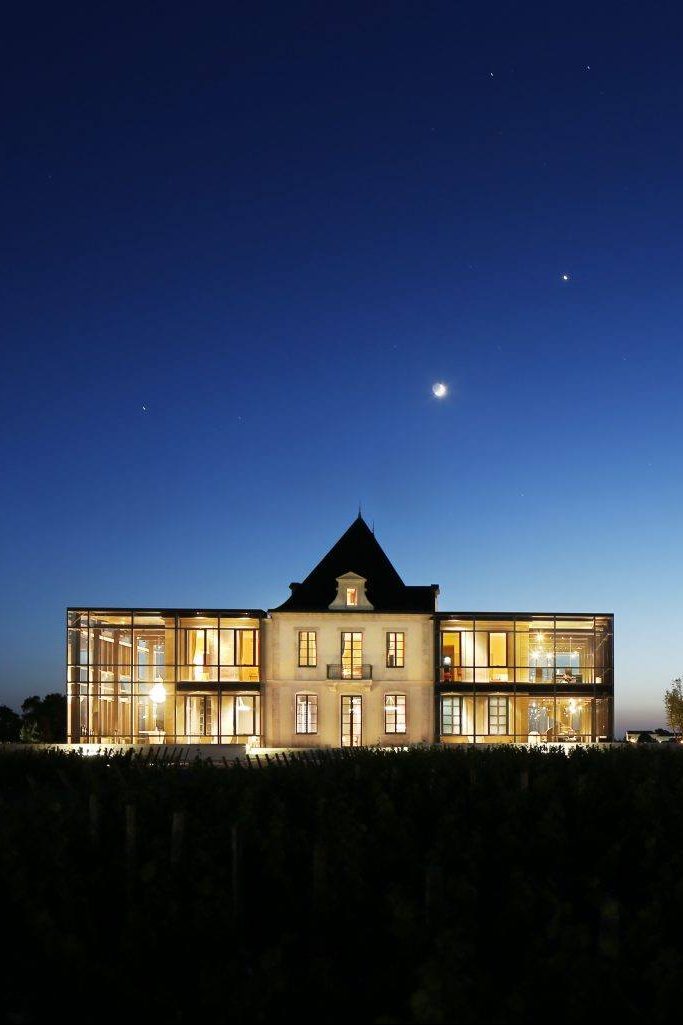There is little doubt that Bordeaux has some of the best and most expensive wines in the world. However, it is not the most scenic place to visit – somewhat flat and rather dull in parts it doesn’t offer a landscape that excites.
What it does offer though, is some of the most diverse and sometimes dramatic architecture in France. Throughout the region there are many examples of classic, eccentric, and contemporary designs. Whether it be in the Medoc, Sauternes or Saint Emilion, there are dozens of chateaux to see.
Probably the most famous of the classic chateaux is Chateau Margaux. The original building was torn down and replaced in 1812 with a neo-Palladian style palace whose unmistakable features pay homage to ancient Greek and Roman architecture. It certainly doesn’t fall into the eccentric category but rather, it epitomises the elegance and finesse the Chateau and the wine have become known for.
2006 Chateau Margaux Premier Grand Cru Classé £505 per bottle
A classic, elegant Margaux that may benefit from another few years in bottle.
Chateau de Malle hasn’t been the most consistent or high quality Sauternes over the last two decades but it does boast some of the best gardens in Bordeaux. Originally designed in the early 18thcentury by Alexandre Eutrope de Lur Saluces it is easy to see how heavily influenced he was by his time in Versailles and Italy. The grand Renaissance building frames the immaculate terraces that hold statues from Greek mythology and the Italian commedia dell’arte as well as symbols representing wine and wine-making.
2001 Chateau de Malle Sauternes Deuxieme Cru £46 per bottle
One of the best vintages of Chateau de Malle in the last 20 years, this has good depth and a lovely creamy finish. Perfectly aged for drinking now.
The Lur Saluces family also managed Chateau Filhot and had the building rebuilt in the 1840’s. At first glance you could easily mistake it for something out of a Jane Austen novel: a classic English stately home with simple gardens laid to lawn, fruit trees and a pond for the ducks. Like many chateaux in Bordeaux, Filhot has enjoyed varied success with much of it on the basis of fashion and endorsement. Thomas Jefferson, during his time as Ambassador to France, rated Filhot very highly and seconded it only to Yquem. This strong reputation waned over the years though and has never returned to its full glory.
Eccentricity is rarely shied away from in Bordeaux and the Medoc (possibly to make up for its rather dull landscape) has two chateaux that were regarded as off the wall in their time.
Louis Gaspard d’Estournel was nicknamed the Maharaja of Saint-Estephe when he built the new chateau for Cos d’Estournel in 1810. His family were the first in Bordeaux to send their wine to the Indian continent and honoured this relationship with distinctive monumental pagodas and oriental features that can be seen well before you arrive at the property. Elephants, ornately carved wooden doors and perfectly placed palm trees certainly take your mind off the flat plains of the Medoc.
2008 Chateau Cos d’Estournel Saint Estephe Deuxième Grand Cru Classe £125 per bottle
Not the most classic example of a Cos d’Estournel but certainly one of the best from the last 15 years. It will be drinking beautifully now but will last a good few years yet.
In rather stark contrast to the wonders of the orient, Chateau Brown Cantenac in Margaux, was built in the style of a Tudor castle in homage to the owner’s Scottish roots. John Lewis Brown, a Frenchman of Scottish origins, bought the vineyard in 1806 and had the chateau built shortly after. Given the number of wild and outlandish chateaux that now compete with each other on the Bordeaux landscape, this may appear a little tame, but on closer inspection you can certainly appreciate how it would have originally been perceived by the locals.
The 21stcentury has seen a shift in architectural style and focus. It is no longer the chateaux that are taking centre stage but rather the wineries that producers are investing their money in now. A number of owners have employed highly fashionable, successful architects to create state of the art wineries alongside the traditional properties in a juxtaposition that is gradually changing the architectural landscape of the region.
The most well-known is Chateau Cheval Blanc in Saint Emilion where the white curved concrete walls of the new winery take on the appearance of waves rising out of the ground – ‘the winery under the hill’. The chateau itself is understated in comparison to some but is also effortless in its elegance; the low, curved walls of the new winery that sit alongside it strangely compliment this elegance.
Understated elegance is not something you’ll find at La Grace Dieu des Prieurs (Preserved by the Grace of God’s Priors). The current owner, Russian philanthropist Andrey Filatov, commissioned Jean Nouvel, the acclaimed Pritzker prize-winning architect, to create a new winery as well as a place to showcase his other passion ‘Art Russe’. The estate’s new buildings are both functional and works of art. A giant cylindrical vat sits alongside the vines and houses the state of the art winery. Spectacularly decorated both inside and out it rather overshadows the now drab looking Chateau and dominates the landscape.
However, the most astonishing of all is Chateau Pedesclauxin the Medoc. The original chateau has been revamped and, while the central core has been left in all its glory, the two wings have now been encased in glass which, when lit at night are quite something.

